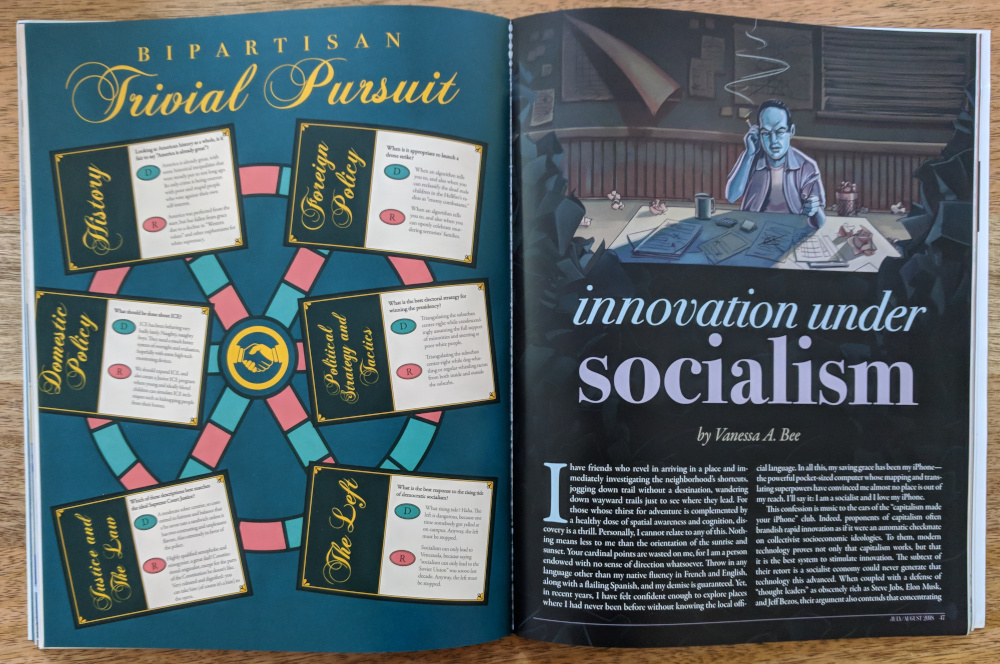In case you missed it, the following reviews have been updated with lots more detail:
Team: Nonprofit Media
We look for quality sources of news and analysis in the public interest
Latest review
In November 2015, Nathan Robinson and Oren Nimni launched a Kickstarter to fund the creation of Current Affairs, a print magazine of “political analysis, satire, and entertainment” promising to “make life joyful again”. The campaign exceeded its goal of $10,000. Three years later, Current Affairs has become of the most reliably interesting and, indeed, enjoyable political publications on the left.
Print editions are issued every two months; each is carefully designed and, in addition to articles on diverse topics, every issue contains the creative works of many contributing artists. While many illustrations simply support a given article, in other cases it’s the illustrations that tell the story—see, for example, the “City of Dreams” illustration and accompanying article.

Recent Current Affairs covers. (Credit: Current Affairs. Fair use.)
Chances are that you’ve come across Current Affairs articles before through some of Nathan Robinson’s in-depth “takedown” articles about prominent American and Canadian political writers — especially those spreading reactionary ideas, e.g., Ben Shapiro, Charles Murray, Sam Harris, Jordan Peterson, Mike Cernovich, and Dinesh D’Souza.
Instead of simply dismissing them outright, Robinson takes these figures to account on the basis of their own words, dissecting the ugly mess of hateful nonsense beneath whatever persona they’ve created for themselves.
Current Affairs is a decidedly leftist publication; it routinely condemns capitalist excess, corporate misconduct, “bipartisan” alliances with murderous regimes, the convenient political amnesia concerning America’s history of horrific military interventions, the dark legacy of racism at the root of deep social and economic inequalities.
While it writes of socialism as a political and economic alternative, the magazine has been equally critical of authoritarian socialism. Robinson’s own essay, “How To Be A Socialist Without Being An Apologist For The Atrocities Of Communist Regimes“, puts it quite plainly:
The dominant “communist” tendencies of the 20th century aimed to liberate people, but they offered no actual ethical limits on what you could do in the name of “liberation.” That doesn’t mean liberation is bad, it means ethics are indispensable and that the Marxist disdain for “moralizing” is scary and ominous.
Current Affairs instead leans towards libertarian socialism, an ideology seeking to balance a high commitment to individual freedom with a concern for the welfare of societies. It speaks of “humanistic” values and holds all ideologies to account for living up to those values.
The magazine publishes essays about diverse topics from the changing politics of Star Trek to the Mardi Gras holiday in New Orleans. You’re in for a visual treat the moment you open the table of contents, each of which is an artistic exploration of the topics covered in the current edition.

Current Affairs table of contents examples. (Credit: Current Affairs. Fair use.)
Alongside its playfulness and occasional silliness, the magazine features articles such as a gut-wrenching and unflinching look back at the Vietnam War (“What We Did”) or an insightful report on disillusioned African-American Rust Belt voters (“The Color of Economic Anxiety”).
Recently, the magazine also launched a podcast; as of this writing, it is already generating more than $6,000/month in Patreon support (supporters get access to bonus episodes). The podcast features conversations between the magazine’s contributors on a wide variety of topics, featuring segments like “Lefty Shark-Tank” (tongue-in-cheek criticism of left-wing policy ideas), interviews, answers to listeners, parody ads, and more.
Legally, Current Affairs is not a nonprofit; Nathan Robinson told me by email that the team “debated it and then decided against it as it creates all kinds of logistical headaches”.
However, he emphasized that Current Affairs will never operate as a for-profit company. Over the course of each magazine’s two-month run, all articles are published online without any kind of paywall, and the website and magazine are entirely free of third party ads. Regrettably, articles are under conventional copyright, as opposed to a permissive Creative Commons license.

Article example from the latest issue. (Credit: Current Affairs. Fair use.)
The Verdict
After reading their online edition for a while, I subscribed to Current Affairs earlier this year, and have not regretted it yet. At $60 for 6 issues, you get good value for your money; the magazine is a pleasure to look at, and I generally read it all the way through before the next one arrives.
A few typos usually slip through, and some articles would benefit from more rigor (data, citations) or additional editing. But these are the kinds of problems you would expect from a small, independent magazine.
In many ways, I prefer the Current Affairs model to the heavily grant-funded nonprofit publications I’ve reviewed (e.g., The Marshall Project, ProPublica). It will likely never be able to muster the resources to engage in a similar scale of reporting projects, but its writing is fearless and independent, funded entirely by readers. While its humor can be snarky, underneath it there’s an earnestness that’s disarming and likable. I highly recommend checking it out.
Would you enjoy reading it? Fortunately, that’s easy to find out by browsing the archives of the website. Regardless of its legal status, I’ve also added it to the Twitter feed of quality nonprofit media, which is a convenient way to sample the content of many nonprofit outlets if you happen to use Twitter.
Team blog
A checklist for reviewing nonprofit media
We have now published a few reviews of non-profit media. Let’s take a closer look at the criteria we can use to assess a non-profit publication (many of which also apply to for-profit media) and how they should influence a source’s rating.
Funding sources
How a source is funded may influence what it reports on. We currently do not review publications that are primarily funded through advertising or by taxpayers. The types of media we are interested in receive funding primarily (>50%) in one or more of the following ways:
- from individual major donors
- from individual small donations
- from foundations that award grants, fellowships, etc. (more on this below)
- from subscriptions
Each of these revenue sources has its own challenges, with subscriptions or small donations providing the broadest base of support and therefore the least leverage for any individual supporter; the effect of such a model does then depend largely on what most the supporters expect from the thing they’re supporting (even neo-nazi websites like Stormfront use funding from individual donors to survive).
The Intercept is an interesting example for how support from a single large donor can grant a significant measure of editorial freedom. The non-profit behind it, First Look Media, was funded by billionaire Pierre Omidyar, receiving $30M funding in its first year. But of course this presents major vulnerabilities as well. There is the possibility of behind-the-scenes meddling, or the organization might simply run out of money.
When major donors become philanthropists, they often set up foundations. These organizations give in accordance with their funders’ wishes. Many of them operate large endowment funds, which generate investment income indefintely (see Wikipedia’s list of the wealthiest foundations).
Non-profit media can apply for grants from foundations, and some rely primarily in such support – see the ProPublica list of supporters, for example. Heavy reliance on foundations may introduce a status quo bias: typically the creation of millionaires or billionaires, they are usually founded with the intent to advocate for an incremental change agenda within the existing political and economic order. They are also reputation-sensitive, and do not themselves want to be targeted by political groups. Their internal decision-making processes may reflect these biases, and penalize grant applicants who propose overly radical projects.
Such concerns are not unwarranted, as the intense targeting of one of the most progressive funders, George Soros’ Open Society Foundations, by right-wing groups demonstrates. Progressives – who are notoriously skeptical of billionaires’ intentions – don’t necessarily jump to their defense, either. As a result, many other philanthropists avoid politics entirely, and focus on diseases, poverty, or other social ills.
There are, of course, also countless reactionary foundations. Organizations like the “Center for Organizational Research and Education” are funded by corporations to advance their agenda, by discrediting scientific research or activist efforts. And progressive organizations like the Center for American Progress have received funding from corporate donors and foreign countries.
To uncover funding networks, the following resources are helpful:
- The ProPublica Nonprofit Explorer, GuideStar and Charity Navigator mine the tax returns (form 990) of US-based non-profit organizations, which include high-level revenue data and top executive compensation.
- Many established charities publish Annual Reports, though they can be difficult to find. Use a Google search with
site:<domain name>. These reports usually include a funding breakdown by source (foundations, individual donations, etc.). - Separately, charities may have pages with names like “Benefactors” or “Our supporters” that list key major donors by name.
- A news search for the charity’s name, the Wikipedia article, and other external sources may provide additional information.
Relation to rating: The funding model should not influence a source’s rating.
Executive compensation
As noted above, US non-profit tax returns do include top salaries. Needless to say, appropriate compensation is highly dependent on geography, and also correlates with organizational size (running a large, complex organization requires a different skillset that warrants higher compensation). With that said, it’s useful to compare executive compensation with non-profits of similar size in the same region. Is it extraordinarily high?
If the organization is currently dependent on a few large revenue sources like major donors and foundations, excessive compensation may make it more difficult to achieve a broader base of support as soon as these numbers receive greater scrutiny. And of course there’s the practical question of how much the charity can achieve for a given dollar if it pays more for certain roles than it needs to.
Relation to rating: This should only influence a source’s rating to the extent that it appeals for public support.
Overhead vs. Waste
You may have heard of “overhead ratios” and similar efficiency assessments: how much of a charity’s work goes towards programmatic work (such as journalism) and how much goes towards administrative support (such as fundraising, office equipment, etc.).
These ratios are now widely regarded as counterproductive by nonprofit experts, because they can be easily gamed (the functional allocation of expenses is done by the nonprofit itself and contains a lot of loopholes), because honest organizations may get penalized, and because they may disincentivize necessary investments that increase the organization’s effectiveness.
As such, I never look at an overhead ratio by itself, but I do scrutinize Annual Reports, financial statements and other records to look for evidence of wasteful spending. An example would be excessive spending on executive offsite meetings, consultants engaging in runaway planning projects, and so on.
Relation to rating: Wastefulness should influence a source’s rating to the extent that it appeals for public support.
Transparency
This brings us to the broader question of what we can learn about an organization and its inner workings. The information I expect to find on a well-run non-profit’s website includes:
- information about the tax deductibility of donations
- the latest Annual Report or at least a list of benefactors
- the latest tax returns and financials
- information about the Board and Staff (at least leadership)
- contact information
If such information is nowhere to be found, that doesn’t mean anyone is trying to hide something. Organizations go through stages of development, and developing an understanding of good governance is part of that process. What’s disappointing is when a well-funded organization does a poorer job with this than a scrappy one.
Relation to rating: A well-established, well-funded organization can be penalized for lack of transparency.
Positioning
A source may position itself in different ways, e.g., as center-left, or religious right, or far left, and this may be expressed in the form of editorials, analysis, and most importantly, coverage. Which stories receive attention and why, and which ones don’t? Which views are dismissed as “unrealistic” or “extreme”? Does the source obsesesively target the same person over and over again, resulting in an unbalanced perception of reality?
I don’t believe that there is “neutral” positioning for a news source. Selection of topics, scope of coverage, placement of stories, etc. are all “opinionated” decisions, made by humans with a perspective on how the world works, or by human-created algorithms optimizing towards a specific outcome like ad revenue. Nobody would want to read an actually neutral news source: positioning and curation are crucial functions of all news media.
In order to identify positioning:
- We can look at the way a source describes itself, or the founder has described it.
- We can look at the aforementioned funding questions to give us some clues. Funders with specific leanings tend to fund consistently with those leanings.
- We can spot check topical coverage:
- How are climate movements like “Keep it in the Ground” treated?
- How are different political candidates treated?
- How are revelations by major whistleblowers like Edward Snowden presented?
- We can look at the editorial pages. Do they restrict themselves to a narrow band of opinions, and if so, which band is it?
- What “experts” are consulted by the source? (See SourceWatch’s list of industry-friendly experts, for example.)
- Does the publication engage in false balance?
Relation to rating: Positioning itself should not influence the rating, but answers to the above question may, especially insofar as they relate to manipulative intent (see below).
Manipulative intent, gross negligence, sensationalizing
Beyond their positioning (which shapes our views through what is included and excluded), media can manipulate our views is subtle and notoso-subtle ways:
-
Deliberate distortion. The typical example would be an out of context quote. This has been noted in the example of UK politican Jeremy Corbyn, for example: How to speak Corbyn: A Headline Writer’s Guide But there are many other ways to misrepresent a story, omit crucial context, or sensationalize. Clickbait sites on the left are not immune to this charge.
-
Gross negligence. Imagine building a whole story on the basis of an unverified tweet by a random person on the Internet. Pipelines of media can normalize gross negligence: from Twitter to Infowars or Zerohedge to Breitbart or Daily Caller to National Review or Fox News.
-
Sensationalizing. The classic example here is the tabloid screaming of a scandal in letters taking up much of the page. The more modern example would be a clickbait headline. A source may report something real, but may do it using hyperbolic language, moral condemnation, exaggerated interpretations, calls to action, and so on.
In all these cases, it’s worth looking not just for evidence that such things occur (which is fairly easy, and supported by fact-checking sites like Politifact, Snopes, and so on), but also whether they follow a pattern consistent with the source’s positioning.
Relation to rating: A source may be penalized consistent with the extent to which it engages in these practices.
Mechanism for corrections
Is there a way to report an error? If so, does it actually result in any acknowledgment or follow-up? I highly recommend testing this with any source whenever you spot an error. The results can be enlightening.
Relation to rating: This is a minor consideration.
Scope
What does the news source actually cover? Is it a global, national, locally focused source? Is it restricted to certain topics? Does it include editorials, news, original interviews, cartoons, etc.? The answers shouldn’t reflect well or poorly on the source, but do help readers decide what other sources they might want to add to their mix to even things out.
Relation to rating: Scope should not affect the rating.
Reader engagement
Does the source have a discussion forum? If so, does it have any moderation mechanism, protection against forum spam, etc.? Are there other ways for readers to get involved, e.g., through citizen journalism projects?
Relation to rating: This is a minor consideration.
Licensing
Most content is uner conventional copyright: you can’t use it without the author’s permission (fair use exemptions notwithstanding). For organizations dedicated to advancing the public interest in some way, this can be dissonant. There is an alternative: Creative Commons licensing. It lets an author say: “I want anyone to be able to use it, but only if they credit me by name”. Or “I want anyone to be able to use it, but not commercially.”
Wikipedia, for example, uses the Creative Commons Attribution Share/Alike-License. It requires attribution, and if you share a modified version, your changes have to be made under the same terms. This license is also used by some non-profit media, such as Common Dreams. Many, however, likely have never heard of this option.
Relation to rating: This is a minor consideration.
Team Profile
We believe the profit motive harms the integrity of information in news media. It incentivizes sensationalism and introduces coverage biases toward owners and advertisers.
We’re on the look-out for media sources that follow a different funding model or are entirely volunteer-driven.
Highly reviewed national or international English language media are added to this Twitter list, which lets you easily subscribe to the whole batch or follow individual ones you care about.
Our current top 5 to review:
Number of members: 8 (view list)
Number of reviews: 27
Moderators:
- Eloquencefounder
Any source tagged with this team must not be primarily advertising funded. We don’t currently aim to review primarily state-funded media.
See our detailed checklist for tips on what to look for and how to rate.